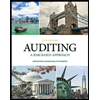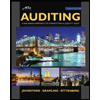
Introduction:
The Code of Professional Conduct of the American Institute of Certified Public Accountants describes Principles and Rules. The principles provide the framework for the rules which govern the performance of professional services by members. It outlines CPAA’s ethical and professional responsibilities. The code establishes Principles which are: Public Interest, Integrity, Objectivity, Independence, Responsibility and Due care.
The four parts of the AICPA Code of Professional Conduct are principles, rules of conduct, interpretations of the rules of conduct and ethical rulings. Of these parts, only the rules of conduct are enforceable.
Principles set the ideal standards related to ethical conduct while rules imply the minimum standards of ethical conduct stated as specific rules.
To select: The correct option.
Want to see the full answer?
Check out a sample textbook solution
Chapter 19 Solutions
AUDITING LL W/ CONNECT <C>
- What is the Net Present Value (NPV) of a project?A) The initial investment in a projectB) The difference between the present value of cash inflows and outflowsC) The expected cash inflows from a projectD) The total cost of financing a project need help!arrow_forwardWhat is the Net Present Value (NPV) of a project?A) The initial investment in a projectB) The difference between the present value of cash inflows and outflowsC) The expected cash inflows from a projectD) The total cost of financing a projectarrow_forwardWhat is the Payback Period in capital budgeting?A) The time it takes to recover the initial investmentB) The time it takes to achieve profitabilityC) The time it takes to double the investmentD) The time it takes to reach maximum revenuearrow_forward
- Required: Suppose you conduct currency carry trade by borrowing $1 million at the start of each year and investing in the New Zealand dollar for one year. One-year interest rates and the exchange rate between the U.S. dollar ($) and New Zealand dollar (NZ$) are provided below for the period 2000 - 2009. Note that interest rates are one-year interbank rates on January 1st each year, and that the exchange rate is the amount of New Zealand dollar per U.S. dollar on December 31 each year. The exchange rate was NZ$1.9090 per $ on January 1, 2000. Fill out columns (4) - (7) and compute the total dollar profits from this carry trade over the ten-year period. Also, assess the validity of uncovered interest rate parity based on your solution of this problem. You are encouraged to use the Excel spreadsheet software to tackle this problem. Note: Negative value should be entered with a minus sign. Enter profit value answers in dollars, rather than in millions of dollars. Do not round intermediate…arrow_forwardWhich of the following is considered a capital budgeting decision?A) Deciding how to finance a new projectB) Deciding whether to replace a machineC) Deciding how to manage cash reservesD) Deciding how to structure employee benefitsarrow_forwardOmni Advisors, an international pension fund manager, uses the concepts of purchasing power parity (PPP) and the International Fisher Effect (IFE) to forecast spot exchange rates. Omni gathers the financial information as follows: Base price level Current U.S. price level Current South African price level Base rand spot exchange rate Current rand spot exchange rate Expected annual U.S. inflation Expected annual South African inflation 100 105 111 $ 0.195 $ 0.178 7% 5% 10% 8% Expected U.S. one-year interest rate Expected South African one-year interest rate Required: Calculate the following exchange rates (ZAR and USD refer to the South African rand and U.S. dollar, respectively): a. The current ZAR spot rate in USD that would have been forecast by PPP. Note: Do not round intermediate calculations. Round your answer to 4 decimal places. b. Using the IFE, the expected ZAR spot rate in USD one year from now. Note: Do not round intermediate calculations. Round your answer to 4 decimal…arrow_forward
- You invest $5,000 in a project, and it generates $1,250 annually. How long will it take to recover your investment? Exparrow_forwardThe value of an investment grows from $10,000 to $15,000 in 3 years. What is the CAGR?Soovearrow_forwardSuppose that the treasurer of IBM has an extra cash reserve of $100,000,000 to invest for six months. The six-month interest rate is 9 percent per annum in the United States and 8 percent per annum in Germany. Currently, the spot exchange rate is €1.07 per dollar and the six-month forward exchange rate is €1.05 per dollar. The treasurer of IBM does not wish to bear any exchange risk. Where should they invest to maximize the return? Required: The maturity value in six months if the extra cash reserve is invested in Germany:arrow_forward
- The value of an investment grows from $10,000 to $15,000 in 3 years. What is the CAGR?arrow_forwardYou invest $5,000 in a project, and it generates $1,250 annually. How long will it take to recover your investment?arrow_forwardA company pays an annual dividend of $3 per share, and the current stock price is $50. What is the dividend yield?arrow_forward
 Auditing: A Risk Based-Approach (MindTap Course L...AccountingISBN:9781337619455Author:Karla M Johnstone, Audrey A. Gramling, Larry E. RittenbergPublisher:Cengage Learning
Auditing: A Risk Based-Approach (MindTap Course L...AccountingISBN:9781337619455Author:Karla M Johnstone, Audrey A. Gramling, Larry E. RittenbergPublisher:Cengage Learning Auditing: A Risk Based-Approach to Conducting a Q...AccountingISBN:9781305080577Author:Karla M Johnstone, Audrey A. Gramling, Larry E. RittenbergPublisher:South-Western College Pub
Auditing: A Risk Based-Approach to Conducting a Q...AccountingISBN:9781305080577Author:Karla M Johnstone, Audrey A. Gramling, Larry E. RittenbergPublisher:South-Western College Pub- Business Its Legal Ethical & Global EnvironmentAccountingISBN:9781305224414Author:JENNINGSPublisher:CengageBusiness/Professional Ethics Directors/Executives...AccountingISBN:9781337485913Author:BROOKSPublisher:Cengage





